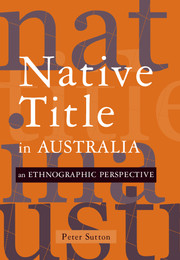Book contents
- Frontmatter
- Contents
- List of Figures
- Acknowledgements
- Introduction
- Map
- Chapter 1 Kinds of Rights in Country
- Chapter 2 Local Organisation Before the Land Claims Era
- Chapter 3 Aboriginal Country Groups
- Chapter 4 Atomism versus Collectivism
- Chapter 5 Underlying and Proximate Customary Titles
- Chapter 6 The System Question
- Chapter 7 Kinship, Filiation and Aboriginal Land Tenure
- Chapter 8 Families of Polity
- Notes
- References
- Index
Introduction
Published online by Cambridge University Press: 22 September 2009
- Frontmatter
- Contents
- List of Figures
- Acknowledgements
- Introduction
- Map
- Chapter 1 Kinds of Rights in Country
- Chapter 2 Local Organisation Before the Land Claims Era
- Chapter 3 Aboriginal Country Groups
- Chapter 4 Atomism versus Collectivism
- Chapter 5 Underlying and Proximate Customary Titles
- Chapter 6 The System Question
- Chapter 7 Kinship, Filiation and Aboriginal Land Tenure
- Chapter 8 Families of Polity
- Notes
- References
- Index
Summary
Through much of their history, anthropological studies of Aboriginal land and marine tenure have been focused on contemporary groups with strongly surviving classical traditions, or on reconstructing those traditions for people whose social and cultural lives have been even more greatly changed since Australia's colonisation by Britain in the eighteenth and nineteenth centuries. Following the arrival of legislative schemes for recognising customary Aboriginal land rights, beginning in the 1970s but reaching a high level of activity since the passage of the Native Title Act 1993 (Commonwealth), more anthropological attention has been given to current relationships between ‘country’ and Aboriginal people of a wide range of cultural backgrounds, including those who live in urban and rural circumstances as well as those in remoter areas where older traditions have better survived.
This book attempts to take into account this wide range of information in order to discuss the major issues confronting Aboriginal native title claimants and title holders and those who seek or hold recognised rights under state and territory land and marine rights legislation. The emphasis, however, is on the native title context. Readers unfamiliar with the bewilderingly complex Australian native title legal and bureaucratic apparatus should familiarise themselves with the basic relevant literature if they want further background on the state of the law and its interpretation and implementation. The issues covered in this book are currently faced by legal, bureaucratic and anthropological practitioners, whether the context is one of native title determinations by consent or by litigation.
- Type
- Chapter
- Information
- Native Title in AustraliaAn Ethnographic Perspective, pp. xiii - xxiPublisher: Cambridge University PressPrint publication year: 2003

